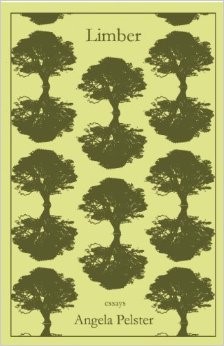152 pages, $15.95
Review by Mieke Eerkens
In Syracuse, New York, there is an artist, and his art is trees. His masterpiece is the Tree of 40 Fruits, which is exactly what it says it is. Painstakingly, the artist has grafted up to 40 varieties of fruit, chosen for the specific shade of their blossoms, onto one trunk. That trunk feeds the 40 limbs that grow from it. In the spring, the tree bursts into a balanced, integrated mosaic of color. It is a thing of beauty.
So too, is the tree-themed essay collection, Limber, the debut book from Angela Pelster, a 2012 graduate of the University of Iowa’s Nonfiction Writing Program. Like the varieties blooming on the Tree of 40 Fruits, Pelster manipulates individual essays with a deft hand into a singular collection that avoids feeling forced or thematically trite, which, let’s face it, is a certain danger when a writer chooses to write around the construct of a central image. Pelster side-steps that danger by self reflexively winking at her own subjective hand in constructing and exploiting that thematic scaffolding to explore a variety of other issues. For example, Pelster announces the book’s intentions metaphorically at the end of the short introductory essay, “By Way of Beginning,” which recounts the story of a man who plays cross-sections of a tree on a record player: “The rings are a memory of what the seasons brought and what the tree made of it…[E]ven a tree will only tell the story it wants to tell.”
Fans of the genre-bending trend in contemporary essays will love this collection, which cares not a hoot about labels or the boxes into which you wish to push language. Pelster’s essays play with form and borrow liberally from the conventions of fables and parables from different cultures, Biblical texts, poetry, and fiction. In “The Boys of Lake Karachay”, Pelster recounts the experiences of a community in the Russian Ural Mountains where a chemical plant’s pollution of the region’s rivers spreads cancer through the community. Pelster invokes language reminiscent of the dark Aesops fables: “One night, maybe the townsfolk say, the ghosts of the boys climbed the dead fir trees along the shore and called to Rusalka until she came up from the lake, wailing, in coarse black hair, eyes growing on her hands and neck, her feet webbed and her breasts gaping wounds.” As is typical of all these essays, we then get a surprising twist that reveals what has been at the essay’s core all along. In the final sentences, Pelster describes the cancer of one of the boys, Artyom: “Even cancer cells only want to live; life will take hold of life wherever it can…When the surgeon opened Artyom’s ribs and cut into his lungs, he found nestled in the red folds and poking into the capillaries a small, green fir tree.”
In “Moon Trees,” Pelster weaves several historical folktales together. She launches us into the essay with a legend about the moon’s cinnabar or katsura tree, believed by ancient Chinese and Japanese cultures to be responsible for turning the moon red. This evolves in a delightfully strange way to merge with ancient European myths about the “Man in the Moon,” who was banished there by Moses for gathering sticks on the Sabbath. Pelster doesn’t mention the origin of these legends – for that, I had to consult Google—but weaves them together as one dreamy, cohesive tale. Onto this collapsed human-lunar history, she quite suddenly lands space mission Apollo 14, which brought tree seeds to the moon and back. The seeds were planted in various locations as “Moon Trees.” They are now largely unknown and forgotten, absorbed into modern folklore.
What’s refreshing about this collection beyond the gorgeous, lyrical prose, is the modernist way that Pelster continuously plays with convention, whether that’s formally, as with the sectioned essays like “Portrait of a Mango,” which brings to mind Wallace Steven’s “13 Ways of Looking at a Blackbird,” or conceptually, as Pelster continuously calls attention to the text as a subjective construct. For example, in “Portrait of a Mango” she tells her mother about the essay we are reading, “I wrote you into a conversation we haven’t had yet.” In “Rot,” Pelster writes about decaying leaves and a rotting squirrel corps in her yard, but ends the essay by calling out her own metaphor: “Once, when my once respectable father started smoking crack, I thought I saw him stumble in front of my car as I stopped at a crosswalk,” she writes. “Who needs another tree metaphor? One morning I woke up and the rotting squirrel was just gone.” One beautiful essay, “Inosculation,” foregoes the nonfiction convention of writer as observer, and is written in the first person point of view of its subject. Pelster clearly doesn’t care about the false notion in nonfiction that there is any such thing as an objective observer and that essays need to be mutually exclusive with the author’s invention and imagination.
Pelster’s interpretation of the events detailed in this collection reveals a thoughtful, creative, surprising mind. Like a trunk onto which many varieties of tree are grafted, Limber unapologetically shows the hand of the artist in its crafting. And that’s a good thing. I’m delighted to see this joyful experimentation with the essay as a genre. The result is a colorful, harmonious, odd thing of beauty.
***
Mieke Eerkens’ work has appeared in The Atlantic, Creative Nonfiction, Los Angeles Review of Books, The Rumpus, Guernica, and the Norton anthology Fakes, among others. She has received fellowships from the James Merrill House and VCCA, and earned an MFA in Nonfiction from the University of Iowa, where she currently teaches undergraduate creative writing.
![[PANK]](http://pankmagazine.com/wp-content/themes/pank/assets/images/pank-logo-large.png)

